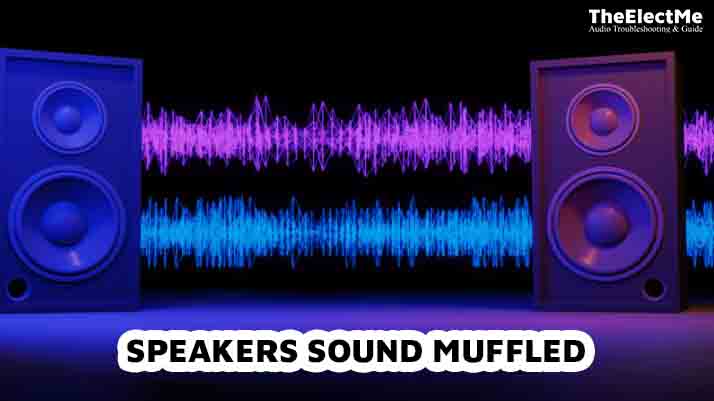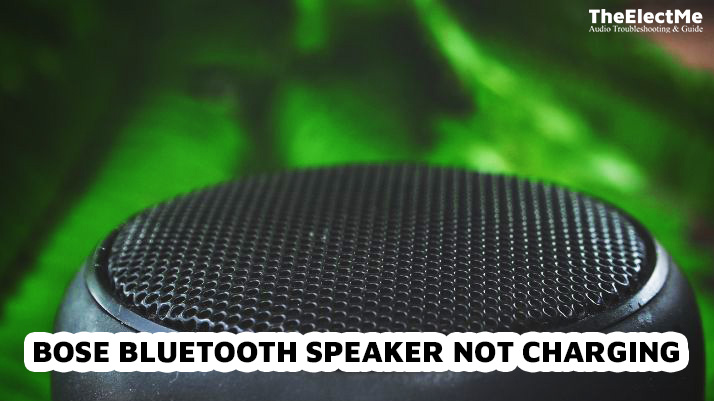Incorrect audio settings, speaker damage, or poor audio quality can cause speakers sound muffled. Knowing the ins and outs of these issues will empower listeners to fix problems promptly and efficiently. This way, they can return to enjoying their audio content with optimal sound quality.
Speakers sound muffled can turn a pleasant listening experience into a frustrating ordeal. Read the blogpost to find out why it happens and how to fix it in no time. Let’s unravel them.

Top 5 Reasons Behind Muffled Speaker Sound
Do you hear a muffled sound when playing music, watching videos, or making calls? Here are the top 5 reasons why your speakers may be giving you a muted audio experience:
Reson No.1: Incorrect Audio Settings
Audio settings play a significant role in the sound quality that speakers produce. Incorrect settings can lead to various sound issues, including a muffled output. For instance, if the equalizer settings are not balanced, it can cause some frequencies to overpower others, resulting in a distorted or muffled sound.
Similarly, if the bass is set too high, it can drown out the higher frequencies, creating a muffled effect. Additionally, audio may get muffled with activated surround sound on unsupported speaker setups.
How do you correct an incorrect audio setting?
To rectify this issue, consider the following steps:
- Access the sound settings on your device. The process varies based on your device: computer, smartphone, or dedicated audio equipment.
- Look for the equalizer settings. They might be under “Sound Effects,” “EQ,” or similar.
- Adjust the frequencies. Start with a flat setting (all frequencies set to the same level) and then adjust according to your preference.
- Check the bass settings. If it’s too high, try reducing it until the sound becomes clear.
- If your setup doesn’t support surround sound, ensure it’s deactivated.
- Test the sound after each adjustment to see if the muffled sound has been resolved.

Every speaker and listener is unique. What works best for one setup might not work for another. It’s all about finding the perfect balance that suits your listening preference.
Reason No.2: Speaker Positioning
Speaker placement significantly impacts sound quality. Improper speaker positioning can cause sound waves to bounce off surfaces, leading to phase cancellation.
This occurs when two sound waves of the same frequency interfere, causing a muffled or distorted sound. Placing speakers near walls or corners boosts low frequencies, muffling sound and overpowering other audio.
How to position your speakers correctly?
To optimize speaker positioning, consider the following tips:
- Avoid Corners and Walls: Keep speakers at least a few feet away from walls and corners. This space allows sound waves to disperse properly, providing a balanced sound.
- Consider the Room Size: Larger rooms require more powerful speakers to fill the space with sound effectively.
- Conversely, too-powerful speakers can overwhelm smaller rooms, causing a muffled effect.
- Position at Ear Level: Ideally, speakers should be at ear level for the listener. This position ensures sound waves are directed straight to the listener for clear sound.
- Angle Speakers Correctly: Speakers should be angled towards the listener. This setup minimizes sound wave reflection, reducing muffled sound from walls and surfaces.
- Maintain Symmetry: Place the speakers symmetrically around the listening position for a stereo setup. This symmetry ensures a balanced soundstage.
The optimal setup can vary based on the room’s acoustics, the type of speakers, and personal preference. It’s worth experimenting with different placements to find the clearest, most enjoyable sound.
Reason No.3: Blocked or Dirty Speaker Openings
Blocked or dirty speaker openings can significantly degrade sound quality, often resulting in a muffled sound. Dust, dirt, and other debris can accumulate over time, obstructing the free flow of sound waves.
A blockage can distort the audio, causing it to sound muffled or muted. In severe cases, it can damage the speaker components.
How to clean your speakers effectively?
To keep your speakers clean and functioning optimally, follow these tips:
- Regular Cleaning: Use a soft, dry cloth to wipe the speaker surfaces regularly and gently. This routine will help prevent dust and dirt buildup.
- Use Compressed Air: For small, hard-to-reach areas, use a can of compressed air to dislodge debris. Keep the can upright and use short bursts to avoid damaging the speakers.
- Avoid Liquids: Unless specifically stated by the manufacturer, avoid using liquids to clean speakers. Moisture can damage the internal components.
- Use a Vacuum Cleaner: A vacuum cleaner with a brush attachment can be useful for heavy dust accumulation. However, use it on a low setting to avoid damaging the speaker cone.
- Professional Cleaning: Consider professional cleaning for heavily soiled speakers or persistent muffled sounds. With specialized equipment and expertise, speakers can be thoroughly cleaned without any damage.

Regular maintenance not only improves sound quality but also extends the lifespan of your speakers. So, make it a habit to keep your speakers clean and dust-free.
Reason No.4: Cable Problems
Faulty or damaged cables can severely impact the sound quality of the speaker, often leading to distorted or muffled sounds. The wires transmit the electrical signals from your audio source to your speakers.
Damaged or improperly connected cables can compromise the signal, producing poor audio quality. Even minor issues like oxidation of cable connectors can degrade the signal and affect the sound.
What is the solution?
To troubleshoot cable problems, consider the following steps:
- Inspect the Cables: Regularly check your cables for visible damage, such as fraying, kinks, or cuts. Also, check the connectors for signs of oxidation or corrosion.
- Check Connections: Ensure that all cables are securely and correctly connected. A loose connection can cause intermittent sound or distortion.
- Test with Different Cables: If you suspect a cable might be the issue, try replacing it with a different one. If the sound improves, you’ve found the culprit.
- Use High-Quality Cables: Saving money on cheaper cables may lead to sound issues. Investing in high-quality cables can improve sound quality and last longer.
Cables are a crucial link in your audio setup. Keeping them in good condition is essential for maintaining optimal sound quality.
Reason No.5: Software or Hardware Updates
Software or hardware updates can cause sound issues due to compatibility problems, bugs, or settings changes. Updates enhance device performance and security but may occasionally cause sound issues. This can result in distorted, low, or no sound at all.
How to resolve this issue?
If you’re experiencing sound problems after an update, here are some troubleshooting steps you can follow:
- Check Sound Settings: Some settings may have been reset or changed after an update. Check your sound settings to ensure everything is configured correctly. This includes volume levels, output device selection, and enhancements or special features.
- Reinstall Updated Software/Hardware: Sometimes, errors may occur during installation. Reinstalling the update can often resolve these issues.
- Update Drivers: If a hardware device was updated, you might need to update its drivers. Drivers are software that allows your hardware to communicate with your operating system. An outdated or incompatible driver can cause sound issues.
- Roll Back the Update: If none of the above solutions work, consider rolling back the update. This will revert your software or hardware to its previous version. Please note that this should be a last resort, as it may leave your device vulnerable to security issues the update aimed to fix.
- Contact Support: If you need help, contact the manufacturer’s support team. They may provide extra troubleshooting steps or information on known update issues.

Updates are essential for maintaining the performance and security of your devices. If an update causes more problems than it solves, don’t hesitate to seek help. After you update the software the placement of speakers may be a big challenge for those who have small space. If you want to place the speaker in a small room read this blogpost: Speaker Placement In Small Room.
Conclusion – Speakers Sound Muffled
To sum up, there are multiple reasons why your speakers sound muffled. It could be due to an incorrect setup, blocked or dirty speaker openings, cable problems, or software/hardware updates.
You can easily resolve the muffled sound by understanding these potential issues and following the tips.
However, if you face persistent sound issues, it’s best to consult a professional for further assistance.
Professional assistance ensures accurate diagnosis and resolution of problems without speaker damage. With proper care, your speakers can provide high-quality audio for years. So keep these tips in mind and enjoy crystal clear sound from your speakers.



